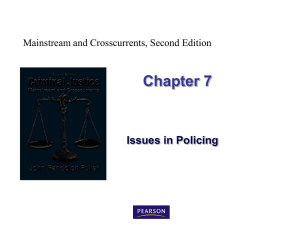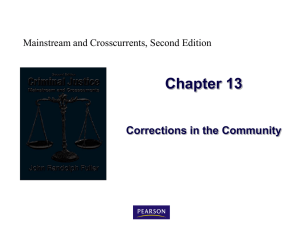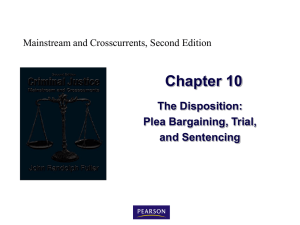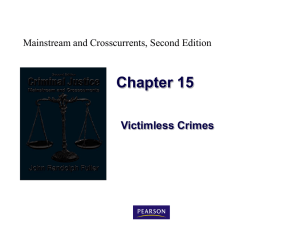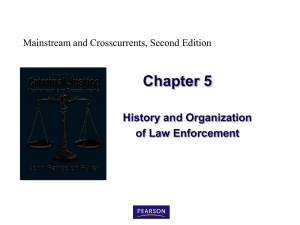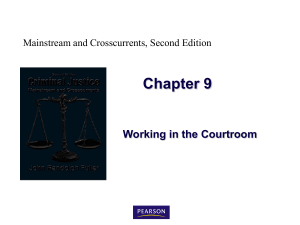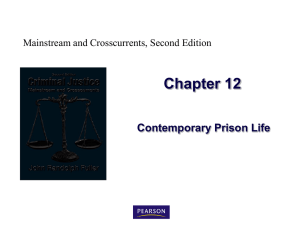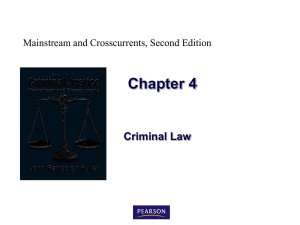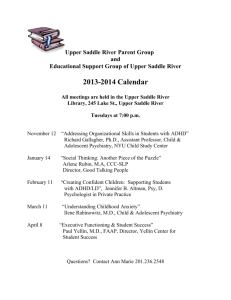CRJU1100 Chapter 6 - Sheriff Larry Waller
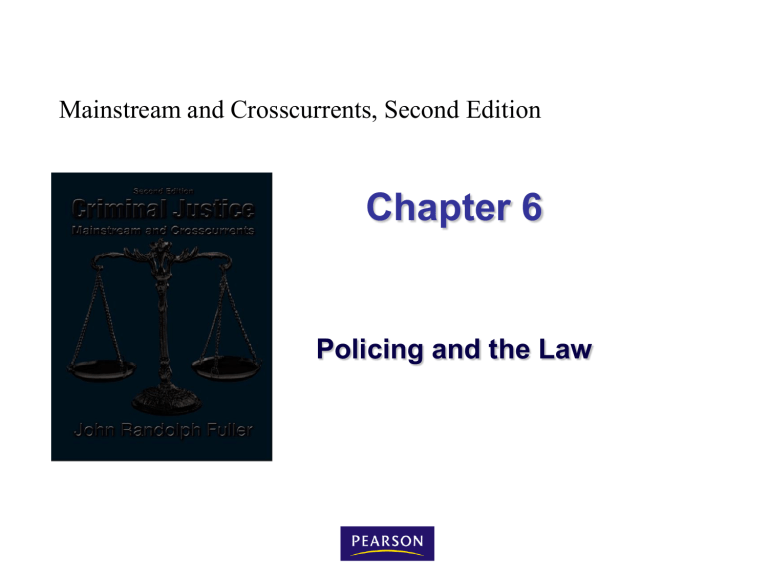
Mainstream and Crosscurrents, Second Edition
Chapter 6
Policing and the Law
What we expect of the police
The police must develop an occupational culture that shapes their response to crime, offenders, and the criminal justice system.
Criminal Justice: Mainstream and Crosscurrents, 2/e
John Randolph Fuller 2
© 2010 Pearson Higher Education,
Upper Saddle River, NJ 07458. • All Rights Reserved.
What we expect of the police
Manning: The police have the tasks of crime prevention, crime detection, and the apprehension of criminal suspects in an efficient, apolitical, and professional manner.
Criminal Justice: Mainstream and Crosscurrents, 2/e
John Randolph Fuller 3
© 2010 Pearson Higher Education,
Upper Saddle River, NJ 07458. • All Rights Reserved.
How the police work
Watchman style
Legalistic style
Service Style
Criminal Justice: Mainstream and Crosscurrents, 2/e
John Randolph Fuller 4
© 2010 Pearson Higher Education,
Upper Saddle River, NJ 07458. • All Rights Reserved.
How the police work
Watchman style
Distinguishes between two mandates of policing: order maintenance and law enforcement.
Involves discretion
Preserving the social order is key
Criminal Justice: Mainstream and Crosscurrents, 2/e
John Randolph Fuller 5
© 2010 Pearson Higher Education,
Upper Saddle River, NJ 07458. • All Rights Reserved.
How the police work
Legalistic style
Concentrates on enforcing the law by writing more tickets, making more arrests, and encouraging victims to sign complaints.
Requires little discretion
Criminal Justice: Mainstream and Crosscurrents, 2/e
John Randolph Fuller 6
© 2010 Pearson Higher Education,
Upper Saddle River, NJ 07458. • All Rights Reserved.
How the police work
Service style
Concerned with service to the community and citizens.
Employs alternative strategies: official warnings or diversion programs.
Discretion is used, but subject to formal review and evaluation.
Criminal Justice: Mainstream and Crosscurrents, 2/e
John Randolph Fuller 7
© 2010 Pearson Higher Education,
Upper Saddle River, NJ 07458. • All Rights Reserved.
The Quasi-military Nature of
Police Organizations
According to Bittner, there are three reasons the military model is attractive to police planners…
Criminal Justice: Mainstream and Crosscurrents, 2/e
John Randolph Fuller 8
© 2010 Pearson Higher Education,
Upper Saddle River, NJ 07458. • All Rights Reserved.
The Quasi-military Nature of
Police Organizations
Both the military and the police are in the business of using force.
The introduction of military-like discipline in the 1950s professionalized police departments.
The police lacked other models of organization.
Criminal Justice: Mainstream and Crosscurrents, 2/e
John Randolph Fuller 9
© 2010 Pearson Higher Education,
Upper Saddle River, NJ 07458. • All Rights Reserved.
The Quasi-military Nature of
Police Organizations
The major difference between military organizations and the police is discretion .
Criminal Justice: Mainstream and Crosscurrents, 2/e
John Randolph Fuller 10
© 2010 Pearson Higher Education,
Upper Saddle River, NJ 07458. • All Rights Reserved.
The Quasi-military Nature of Police Organizations
Police as Soldiers
The difference between the police and the military:
Military: Important decisions are made at the top of the chain of command.
Policing: Discretion is vested with the individual police officer
Criminal Justice: Mainstream and Crosscurrents, 2/e
John Randolph Fuller 11
© 2010 Pearson Higher Education,
Upper Saddle River, NJ 07458. • All Rights Reserved.
What the Police Do
Patrol
Investigation
Traffic enforcement
Peacemaking and order maintenance
Criminal Justice: Mainstream and Crosscurrents, 2/e
John Randolph Fuller 12
© 2010 Pearson Higher Education,
Upper Saddle River, NJ 07458. • All Rights Reserved.
What the Police Do
Patrol
To deter crime
Enhance feelings of public safety
Make officers available for service
Criminal Justice: Mainstream and Crosscurrents, 2/e
John Randolph Fuller 13
© 2010 Pearson Higher Education,
Upper Saddle River, NJ 07458. • All Rights Reserved.
What the Police Do
Patrol
Four aspects of response time:
Discovery time
Reporting time
Processing time
Travel time
Criminal Justice: Mainstream and Crosscurrents, 2/e
John Randolph Fuller 14
© 2010 Pearson Higher Education,
Upper Saddle River, NJ 07458. • All Rights Reserved.
What the Police Do
Investigation
Detectives take over evidence gathering so that patrol officers can resume patrol.
Photographers, crime-scene technicians, and others help detectives investigate the case.
Criminal Justice: Mainstream and Crosscurrents, 2/e
John Randolph Fuller 15
© 2010 Pearson Higher Education,
Upper Saddle River, NJ 07458. • All Rights Reserved.
What the Police Do
Traffic Enforcement
Respond to accidents
Detect drunk drivers
Apprehend suspects
Enforce traffic laws
Traffic duties most often bring police officers into close contact with citizens
Criminal Justice: Mainstream and Crosscurrents, 2/e
John Randolph Fuller 16
© 2010 Pearson Higher Education,
Upper Saddle River, NJ 07458. • All Rights Reserved.
What the Police Do
Traffic Enforcement
Criminal Justice: Mainstream and Crosscurrents, 2/e
John Randolph Fuller 17
© 2010 Pearson Higher Education,
Upper Saddle River, NJ 07458. • All Rights Reserved.
What the Police Do
Peacemaking and Order Maintenance
Domestic disputes
Crowd control
Vice
Mental illness
Juveniles
First response
Criminal Justice: Mainstream and Crosscurrents, 2/e
John Randolph Fuller 18
© 2010 Pearson Higher Education,
Upper Saddle River, NJ 07458. • All Rights Reserved.
Rules the Police Follow
Procedural law: Rules for the government
“Tying the hands of the police”?
The underlying values incorporated by the
Constitution must be met.
Criminal Justice: Mainstream and Crosscurrents, 2/e
John Randolph Fuller 19
© 2010 Pearson Higher Education,
Upper Saddle River, NJ 07458. • All Rights Reserved.
Rules the Police Follow
Police discretion
The police do not make an arrest every time they are authorized to do so.
Criminal Justice: Mainstream and Crosscurrents, 2/e
John Randolph Fuller 20
© 2010 Pearson Higher Education,
Upper Saddle River, NJ 07458. • All Rights Reserved.
Rules the Police Follow
Police discretion
The criminal justice system could not effectively deal with so many cases.
The most serious offenders would be obscured by the mass of cases.
Criminal Justice: Mainstream and Crosscurrents, 2/e
John Randolph Fuller 21
© 2010 Pearson Higher Education,
Upper Saddle River, NJ 07458. • All Rights Reserved.
Rules the Police Follow: Police discretion
Selective enforcement
Pro
Selective enforcement may result in less overall crime and less damage to citizens and property.
Con
Violates the idea of fair play. All suspects are not treated equally.
Depends on discretion.
Criminal Justice: Mainstream and Crosscurrents, 2/e
John Randolph Fuller 22
© 2010 Pearson Higher Education,
Upper Saddle River, NJ 07458. • All Rights Reserved.
Procedural laws and policing
The Fourth Amendment
Procedural law controlling the activities of law enforcement is derived from the
Fourth Amendment.
Criminal Justice: Mainstream and Crosscurrents, 2/e
John Randolph Fuller 23
© 2010 Pearson Higher Education,
Upper Saddle River, NJ 07458. • All Rights Reserved.
Procedural laws and policing
The Fourth Amendment
The right of the people to be secure in their persons, houses, papers, and effects, against unreasonable searches and seizures, shall not be violated, and no warrants shall issue, but upon probable cause, supported by oath or affirmation, and particularly describing the place to be searched, and the persons or things to be seized.
Criminal Justice: Mainstream and Crosscurrents, 2/e
John Randolph Fuller 24
© 2010 Pearson Higher Education,
Upper Saddle River, NJ 07458. • All Rights Reserved.
Procedural laws and policing
The Fourth Amendment
Even though it constitutes only one sentence, the Fourth Amendment covers a lot of territory …
Criminal Justice: Mainstream and Crosscurrents, 2/e
John Randolph Fuller 25
© 2010 Pearson Higher Education,
Upper Saddle River, NJ 07458. • All Rights Reserved.
Procedural laws and policing
The Fourth Amendment
Search
Special-needs searches
Seizures
Stop-and-frisk
Arrests
Criminal Justice: Mainstream and Crosscurrents, 2/e
John Randolph Fuller 26
© 2010 Pearson Higher Education,
Upper Saddle River, NJ 07458. • All Rights Reserved.
The Fourth Amendment
Search
Trespass doctrine
Privacy doctrine
Plain-view doctrine
Open-fields doctrine
Public places
Abandoned property
Criminal Justice: Mainstream and Crosscurrents, 2/e
John Randolph Fuller 27
© 2010 Pearson Higher Education,
Upper Saddle River, NJ 07458. • All Rights Reserved.
The Fourth Amendment
Search
Officers must have the approval of a judge to get a search warrant.
However, the court recognizes four major exceptions to the requirement that officers obtain warrants before conducting a search …
Criminal Justice: Mainstream and Crosscurrents, 2/e
John Randolph Fuller 28
© 2010 Pearson Higher Education,
Upper Saddle River, NJ 07458. • All Rights Reserved.
The Fourth Amendment
Search
Searches incident to arrest
Consent searches
Exigent circumstances searches or emergency searches
Vehicle searches
Criminal Justice: Mainstream and Crosscurrents, 2/e
John Randolph Fuller 29
© 2010 Pearson Higher Education,
Upper Saddle River, NJ 07458. • All Rights Reserved.
The Fourth Amendment
Special-needs searches
Inventory searches
Border searches
Airport searches
Searches of prisoners
Searches of probationers & parolees
Searches of students
Employee drug testing
Criminal Justice: Mainstream and Crosscurrents, 2/e
John Randolph Fuller 30
© 2010 Pearson Higher Education,
Upper Saddle River, NJ 07458. • All Rights Reserved.
The Fourth Amendment
Seizures
The Fourth Amendment does not allow illegally seized evidence to be presented in court.
If the police intimidate a suspect so that he/she does not feel free to leave, an illegal seizure may be deemed under the
Fourth Amendment.
Criminal Justice: Mainstream and Crosscurrents, 2/e
John Randolph Fuller 31
© 2010 Pearson Higher Education,
Upper Saddle River, NJ 07458. • All Rights Reserved.
The Fourth Amendment
Stop and frisk
Encompasses two distinct behaviors.
Stops are seizures.
Frisks are searches.
For a lawful frisk, a stop must meet the conditions of a lawful seizure.
Criminal Justice: Mainstream and Crosscurrents, 2/e
John Randolph Fuller 32
© 2010 Pearson Higher Education,
Upper Saddle River, NJ 07458. • All Rights Reserved.
The Fourth Amendment
Stop and frisk
Actual-seizure stops involve officers physically restricting a person's freedom.
Show-of-authority stops involve officers showing their authority and the suspects submitting.
Criminal Justice: Mainstream and Crosscurrents, 2/e
John Randolph Fuller 33
© 2010 Pearson Higher Education,
Upper Saddle River, NJ 07458. • All Rights Reserved.
The Fourth Amendment
Arrests
A higher standard of suspicion of guilt is required.
Requires that police have probable
cause that the suspect committed a crime.
To use deadly force, the officer must believe the suspect to be a threat to others.
Criminal Justice: Mainstream and Crosscurrents, 2/e
John Randolph Fuller 34
© 2010 Pearson Higher Education,
Upper Saddle River, NJ 07458. • All Rights Reserved.
The Fourth Amendment
Arrests
The court recommends four restrictions on home arrests …
The crime should be a felony.
The police must knock and announce.
The arrest should be made in daylight.
The police must meet a stringent probablecause requirement that the suspect is in fact at home.
Criminal Justice: Mainstream and Crosscurrents, 2/e
John Randolph Fuller 35
© 2010 Pearson Higher Education,
Upper Saddle River, NJ 07458. • All Rights Reserved.
The Fourth Amendment
Interrogation, Confessions, and the Exclusionary Rule
Individuals have constitutional rights that must be respected in the questioning process. These rights stem from the Fifth, Sixth, and Fourteenth
Amendments …
Criminal Justice: Mainstream and Crosscurrents, 2/e
John Randolph Fuller 36
© 2010 Pearson Higher Education,
Upper Saddle River, NJ 07458. • All Rights Reserved.
The Fourth Amendment
Interrogation, Confessions, and the Exclusionary Rule
Fifth Amendment self-incrimination clause
Sixth Amendment right-to-counsel clause
Fourteenth Amendment due process clause
Criminal Justice: Mainstream and Crosscurrents, 2/e
John Randolph Fuller 37
© 2010 Pearson Higher Education,
Upper Saddle River, NJ 07458. • All Rights Reserved.
Questions
Why are the police patterned after the military style of organization?
What do we mean by the term procedural law ?
Where in the US Constitution do we find the authority for our laws concerning searches?
Criminal Justice: Mainstream and Crosscurrents, 2/e
John Randolph Fuller 38
© 2010 Pearson Higher Education,
Upper Saddle River, NJ 07458. • All Rights Reserved.
